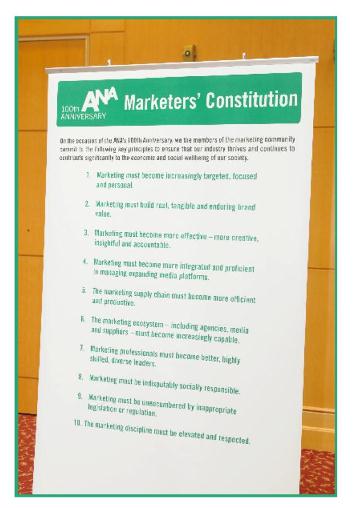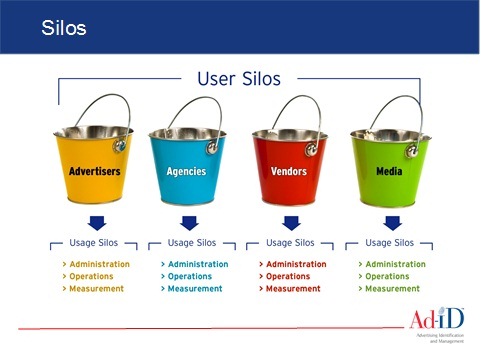The Marketing Supply Chain Needs to Link Up - Harold Geller

We have all heard the phrase, "A chain is only as strong as its weakest link." Truth is, in the current marketing supply chain weak links abound! To successfully create a supply chain which transforms an antiquated linear view to the more apt supply web which a more three dimensional network of partners.
In preparing to present at the East Coast "TV of Tomorrow Show" Event, I started to contemplate the supply chain as it currently exists in the marketplace. There is much good that emerges from a more efficient and productive marketing supply chain; however, there is a lack of understanding among Advertisers and their Agencies as to how to begin to see these benefits.
the supply chain as it currently exists in the marketplace. There is much good that emerges from a more efficient and productive marketing supply chain; however, there is a lack of understanding among Advertisers and their Agencies as to how to begin to see these benefits.
If you refer to Item 5 of The Association of National Advertisers 10 Point Marketer's Constitution The marketing supply chain must become more efficient and productive."
Let's break this down:
What is a supply chain? How does it function? More importantly, why does it function? According to Wikipedia, "A supply chain is a system of organizations, people, technology, activities, information and resources involved in moving a product or service from supplier to customer. Supply chain activities transform raw materials and components into a finished product that is delivered to the end customer."
The long and short of it is that Supply Chain Excellence is what allows manufacturers to deliver to the customer. The more efficiently and effectively it works, the more likely it is that it will function without delay, or malfunction. To be clear, efficiency is different than effectiveness, albeit just as important. Marketing efficiency enables us to shorten the supply chain, reduce waste and improve productivity. The principles of digital workflow throughout the marketing process, when fully embraced by the marketing industry, will improve the accuracy of reporting and evaluation of advertising assets, affording process improvements and cost savings for everyone.
The amount of technological innovation, regardless of the size of the organization, which needs to exist in order to be a value supply web participant, is the same. Firms who are committed to a clear flow of information are more valuable and profitable.
Unfortunately, the entire current system is based on meeting the needs of the customer without giving much regard to the efficiency. Supply chain leaders need to adjust their practices. The ultimate issue here is that in Marketing and Communications we see ourselves in silos and are focused on making sure that advertisers get what they want, when they want it, for the best possible price. Although, what we should be focusing on is ensuring that the process which delivers it from raw materials to consumer usage is efficient. Why should we care? Because there is untapped operating margin.

As you can see in the visual above, each user silo contains the same usage silos reinforcing interoperability.
Many of the exchanges encountered in the supply chain will therefore be between different companies that will seek to maximize their revenue within their sphere of interest, but may have little or no knowledge or interest in the remaining players in the supply chain. More recently, the loosely coupled, self organizing network of businesses that cooperates to provide product and service offerings has been called the Extended Enterprise. This network of firms may operate independently, for example through market mechanisms or cooperatively through businesses and contracts.
There are many other interpretations of Supply Chain Management. The Council of supply-chain management professionals (CSMP) defined Supply Chain Management as: "(it) encompasses the planning and management of all activates involved in sourcing and procurement, conversion, and all logistics management activities. Importantly it also includes coordination and collaboration with channel partners, which can be suppliers, intermediaries, third-party service providers, and customers." In essence supply chain management integrates supply and demand management within and across companies. Supply Chain Management is an integrating function with primary responsibility for linking major business functions and business processes within and across companies into a cohesive and high-performance business model. It includes all of the logistics management activities noted above, as well as manufacturing operations, and it drives coordination of the process and activities with and across marketing, sales, product design, finance and information technology.
This brings me to the Marketers' Constitution Item 6: "The marketing ecosystem – including agencies, media, and suppliers – must become increasingly capable."
In using sophisticated technology and better sourcing tools, best-practice companies are better tuned to opportunities for supply and demand. In spending more time on understanding and maintaining the process, costs plummet, thereby increasing the percentage of revenue.
A multidirectional supply chain gives each member a new found appreciation, understanding and value to their role in the chain. Prohibiting the network from using new found value ultimately depreciates the supply chain itself.
As broadcasters and vendors, there is always a fear that by identifying faults in your customer's processes, your share of the budget will be reduced. By advocating the use of Supply Chain Excellence for ads throughout the supply chain, and across media platforms, we are suggesting that a little work early in the process could make everybody's life a whole lot easier, embracing standardization without inhibiting creativity can improve marketing accountability, generate operational efficiencies, reduce human error and bring value to the Advertiser.
Do you want to be the weakest link? I highly doubt it.
The opinions and points of view expressed in this commentary are exclusively the views of the author and do not necessarily represent the views of MediaBizBloggers.com management or associated bloggers. MediaBizBloggers is an open thought leadership platform and readers may share their comments and opinions in response to all commentaries.

